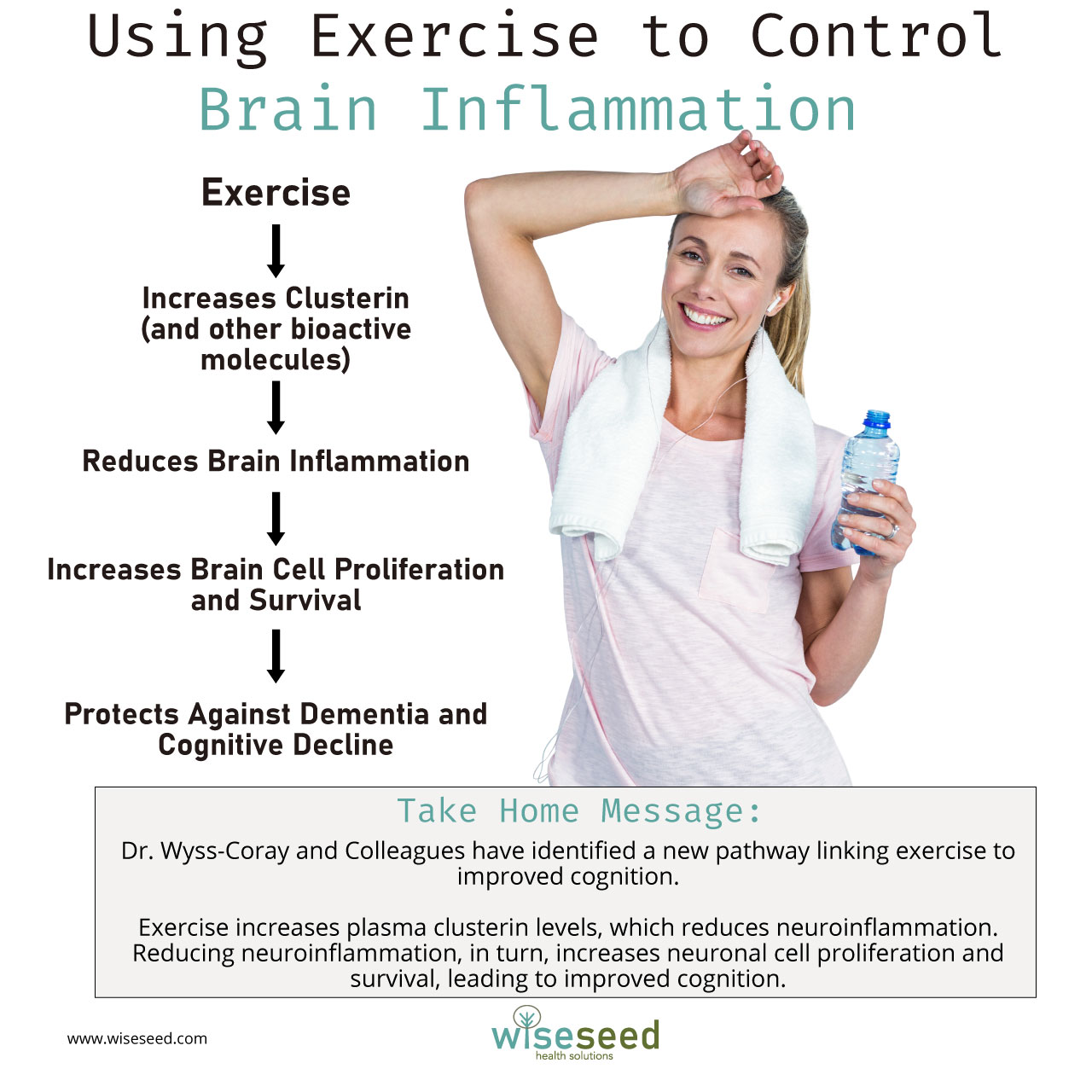How to Build an Anti-Frail Mind: Use Exercise to Control Brain Inflammation

“When it comes to health and well-being, regular exercise is about as close to a magic potion as you can get.”
Tich Nhat Hanh
I’ve written many times about the importance of exercise for preserving your mind.
Not only can exercise preserve your mind, but it may prevent and reverse dementia. For example, voluntary exercise reverses the effects of dementia in mice (1), and high cardiorespiratory fitness reduces the risk of dementia in women (2).
Precisely how exercise protects your brain from the effects of aging and dementia has remained a mystery. However, in a beautiful study just published in Nature, Dr. Tony Wyss-Coray and Colleagues have identified an exercise-brain pathway that helps keep your brain young (3).
What the Researchers Did
Definition: Blood plasma is the colorless liquid of your blood that had had the cells removed and contains salt, hormones, fats, and other nutrients.
Hypothesis and Prediction
Dr. Wyss-Coray and Colleagues hypothesized that exercise releases bioactive molecules into your bloodstream, improving brain function. They predicted that injecting plasma from exercising animals (exercise plasma) into non-exercising animals would transfer the brain-boosting benefits of exercise into sedentary animals (3).
Neural Cell Proliferation and Survival
In mice, twenty-eight days of voluntary exercise increases the proliferation and survival of brain cells compared to sedentary mice (3). The increased proliferation and survival of brain cells confirmed that the exercising mice were experiencing the cognitive benefits of exercise.
So, what happens when you transfer the plasma of exercising mice into their sedentary siblings?
Amazingly, transferring exercise plasma into non-exercising mice increased brain cell proliferation and survival (3). In other words, exercising plasma increases the number of brain cells in sedentary mice without exercising!
Cognitive Performance
But does plasma from exercising mice improve the intelligence of non-exercising mice?
The researchers subjected sedentary mice that had received exercise-plasma to a series of mouse IQ tests to find out. Strikingly, sedentary mice that had received plasma from exercising animals improved their ability to learn and memorize compared to the control mice (3).
Thus, the transfer of exercise plasma improves the cognition of sedentary mice.
How Does Exercise Improve Cognition?
Neuroinflammation
Next, the Researchers noted that exercise-plasma switched off genes involved in neuroinflammation in sedentary mice (3). Observing exercise plasma turns off inflammatory genetic pathways is intriguing because brain inflammation contributes to degenerative brain diseases such as dementia.
Therefore, the researchers attempted to reduce brain inflammation using exercise plasma in an established experimental model of brain inflammation. Sure enough, transfusion of exercise plasma reduced the induced brain inflammation (3).
Thus, exercise reduces brain inflammation.
Clusterin
Clusterin is a plasma protein that mediates many biological effects in mice and humans. Intriguingly, exercise increases plasma clusterin in mice (3). Therefore, the researchers removed clusterin from exercise serum to determine whether clusterin was responsible for reducing brain inflammation. Strikingly, removing clusterin reduced the anti-inflammatory effects of exercise-plasma (3).
Next, the researchers assessed whether pure clusterin could suppress neuroinflammation. And indeed, it could: the transfusion of pure clusterin significantly reduced brain inflammation (3).
Thus, exercise increases plasma clusterin levels, which reduces neuroinflammation.
Human Confirmation
Finally, does exercise increase plasma clusterin levels in human subjects?
The researchers measured plasma clusterin levels in patients with mild cognitive impairment before and after a six-month exercise intervention. The good news is that, as observed in mice, clusterin levels in humans also increase with exercise (3).
Thus, the link between exercise and plasma clusterin appears to be a general mechanism whereby regular exercise reduces neuroinflammation.
Take-Home Message
Dr. Wyss-Coray and Colleagues have identified a crucial new pathway linking exercise to improved cognition.
Regular exercise increases the amount of clusterin in your bloodstream. Clusterin reduces inflammation in your brain, allowing new brain cells to proliferate and survive. By increasing the generation of new brain cells, exercise preserves your ability to learn and remember, and protects you against cognitive decline and dementia.

References and Further Reading
1. X. F. He et al., Voluntary Exercise Promotes Glymphatic Clearance of Amyloid Beta and Reduces the Activation of Astrocytes and Microglia in Aged Mice. Front Mol Neurosci 10, 144 (2017).
2. H. Hörder et al., Midlife cardiovascular fitness and dementia: A 44-year longitudinal population study in women. Neurology 90, e1298-e1305 (2018).
3. Z. De Miguel et al., Exercise plasma boosts memory and dampens brain inflammation via clusterin. Nature, (2021).
Acknowledgments
Images created by Anut21ng and Lordn
Disclaimer
The material displayed on this website is provided without any guarantees, conditions or warranties as to its accuracy.
Information written and expressed on this website is for education purposes and interest only. It is not intended to replace advice from your medical or healthcare professional.
You are encouraged to make your own health care choices based on your own research and in conjunction with your qualified practitioner.
The information provided on this website is not intended to provide a diagnosis, treatment or cure for any diseases. You should seek medical attention before undertaking any diet, exercise, other health program or other procedure described on this website.
To the fullest extent permitted by law we hereby expressly exclude all warranties and other terms which might otherwise be implied by statute, common law or the law of equity and must not be liable for any damages whatsoever, including but without limitation to any direct, indirect, special, consequential, punitive or incidental damages, or damages for loss of use, profits, data or other intangibles, damage to goodwill or reputation, injury or death, or the cost of procurement of substitute goods and services, arising out of or related to the use, inability to use, performance or failures of this website or any linked sites and any materials or information posted on those sites, irrespective of whether such damages were foreseeable or arise in contract, tort, equity, restitution, by statute, at common law or otherwise.

Ten Minutes is All You Need
Research has shown that ten minutes of moderate-to-vigorous exercise performed each day is enough to significantly reduce your risk of early death.





